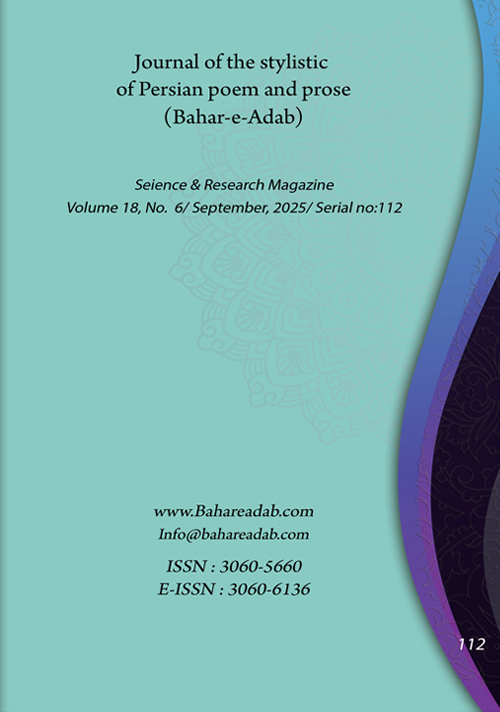- Count View : 45
- آدرس کوتاه شده مقاله: https://bahareadab.com/article_id/1874
- کد doi مقاله: Doi: 10.22034/bahareadab.2025 .18 .7912
Journal of the stylistic of Persian poem and prose
volume Number 18،
number In Volume 6،
،
issue Number 112
The Role of Spiritual Music in Enhancing the Critical Tone of Constitutional Poetry: A Case Study of Mirzadeh Eshghi's Poems
Mahboobeh Safarpour , Asghar Rezapourian (Author in Charge), Mohammad Hakim Azar
Abstract
BACKGROUND AND OBJECTIVES: Constitutional poetry, as a literary reflection of Iran’s socio-political and intellectual transformations during the modern era, served as a fertile ground for articulating a critical and mission-oriented tone. Within this context, semantic music—one of the four dimensions of poetic music as theorized by Mohammad-Reza Shafiei Kadkani—plays a pivotal role in reinforcing thematic coherence, intensifying protest-oriented tones, and enriching the critical discourse of poetry. This study aims to analyze the function of semantic music in shaping and deepening the critical tone of Constitutional poetry, with a focus on the works of Mirzadeh Eshghi.
METHODOLOGY: Employing a descriptive-analytical method grounded in stylistic analysis, this research draws on textual data from Eshghi’s Divan. The investigation centers on rhetorical-semantic devices such as allusion, ambiguity (īhām), antithesis, semantic repetition, synesthesia, paradox, and parallelism (morā‘āt al-naẓīr), exploring how these elements contribute to the construction of semantic music. The theoretical framework is based on Shafiei Kadkani’s theory of poetic music (2012).
FINDINGS: The findings demonstrate that Eshghi’s creative use of rhetorical devices establishes a web of semantic harmony and interrelated meanings that enhances the critical tone of his verse. Semantic music, by generating conceptual symmetries, semantic tensions, and intertextual resonances, transforms his poetry into a medium for socio-political protest, critique, and awareness-raising.
CONCLUSION: In Eshghi’s poetry, semantic music serves not merely as an aesthetic feature but as a discursive and ideological apparatus. In close interaction with rhetorical structures, it facilitates the organization of the critical tone and the articulation of Constitutionalist messages. As such, semantic music may be viewed as a central mechanism in the formation of oppositional poetic voice within Constitutional-era literature.
Keyword
Semantic Music
, Critical Tone
, Constitutional Poetry
, Mirzadeh Eshghi
, Rhetorical Devices
, Stylistics
, Mohammad-Reza Shafiei Kadkani.
- Akhavan al-Safa. (n.d.). Rasa’il Ikhwan al-Safa [The Epistles of the Brethren of Purity] (Trans. and commentary by Hassan Hassanzadeh Amoli). Qom: Hikmat Publications.
- Ajand, Y. (2001). The Evolution of Persian Poetry in the Constitutional Era. Tehran: Iranian Academy of Culture, Art, and Communication.
- Baraheni, R. (2002). Gold in Copper (5th ed.). Tehran: Negah Publications.
- Zarrinkoub, A. (2005). In the Realm of Conscience. Tehran: Sokhan.
- Shafiei Kadkani, M. R. (2012). The Music of Poetry. Tehran: Negah Publishing.
- Eshghi, M. R. M. (2011). Collected Illustrated Poems of Mirzadeh Eshghi, Ed. Ali Akbar Moshir Salimi. Tehran: Amir Kabir.
- Gholami, A. (2014). A Social History of Poetry in the Constitutional Period. Tehran: Mehr Andish.
- Fotouhi, M. (2013). Applied Stylistics. Tehran: SAMT.
- Farshidvard, K. (1994). On Literature and Literary Criticism. Tehran: Amir Kabir.
- Farshidvard, K. (1994). Meanings and Figures of Speech. Tehran: SAMT.
- Ghaed, M. (2001). Portrait of an Anarchist. Tehran: Tarh-e No.
- Karimi-Hakkak, M. R. (2005). The Dawn of Modernity in Persian Poetry (Trans. Hossein Payandeh). Tehran: Morvarid.
- Kiani, F. (2021). A Stylistic Analysis of Constitutional Poetry with Emphasis on Language and Rhetoric. Tehran: Institute for Humanities and Cultural Studies.
- Nafisi, S. (2001). History of Prose and Poetry in Iran and the Persian Language. Tehran: Negah.
- Hasheminejad, G. (1977). Mirzadeh Eshghi; The Poet of Revolution. Tehran: Amir Kabir.
- Homaei, J. (1988). Rhetoric and Literary Devices. Tehran: University of Tehran Press.
- Articles
- Bagheri, K. & Zare, F. (2019). “The Role of Semantic Music in Highlighting Themes in Contemporary Ghazal Poetry.” Persian Language and Literature Research Journal, Lorestan University, 12(2), 95–114.
- Sarkouhi, F. (1998). “Poetry and Politics in Contemporary Iran.” Adineh, 143, 45–51.
- Heydari Nia Naeini, H. & Shahab Razavi, S. H. (2014). “Simile in Eshghi’s Poetry as a Stylistic Feature.” Stylistics of Persian Prose and Verse, 7(4), 93–107.
- Theses
- Fattahi, M. (2018). An Analysis of Musical Structure in Constitutional Era Poetry (Doctoral Dissertation). University of Isfahan, Faculty of Literature and Humanities.
- International
- Eagleton, T. (1996). Literary theory: An introduction (2nd ed.). Minneapolis: University of Minnesota Press.
- Jakobson, R. (1960). Closing statement: Linguistics and poetics. In T. Sebeok (Ed.), Style in language (pp. 350–377). Cambridge, MA: MIT Press.
- 9. Althusser, L. (1971). Lenin and philosophy and other essays (B. Brewster, Trans.). New York: Monthly Review Press.

